n <- length(a) ## `a` must be sorted in non-decreasing order already
plot(a, 1:n / n, type = "s") ## "staircase" plot; not "line" plot
However I'm looking to find the derivative of b
In samples-based statistics, estimated density (for a continuous random variable) is not obtained from ECDF by differentiation, because the sample size is finite and and ECDF is not differentiable. Instead, we estimate the density directly. I guess plot(density(a)) is what you are really looking for.
a few days later..
Warning: the following is just a numerical solution without statistical ground!
I take it as an exercise to learn about R package scam for shape constrained additive models, a child package of mgcv by Prof Wood's early PhD student Dr Pya.
The logic is as such:
- using
scam::scam, fit a monotonically increasing P-spline to ECDF (you have to specify how many knots you want); [Note that monotonicity is not the only theoretical constraint. It is required that the smoothed ECDF are "clipped" on its two edges: the left edge at 0 and the right edge at 1. I am currently using weights to impose such constraint, by giving very large weight at two edges]
- using
stats::splinefun, reparametrize the fitted spline with a monotonic interpolation spline through knots and predicted values at knots;
- return the interpolation spline function, which can also evaluate the 1st, 2nd and 3rd derivatives.
Why I expect this to work:
As sample size grows,
- ECDF converges to CDF;
- P-spline is consistent so a smoothed ECDF will be increasingly unbiased for ECDF;
- the 1st derivative of smoothed ECDF will be increasingly unbiased for PDF.
Use with caution:
- You have to choose number of knots yourself;
- the derivative is NOT normalized so that the area under the curve is 1;
- the result can be rather unstable, and is only good for large sample size.
function arguments:
x: a vector of samples;n.knots: number of knots;n.cells: number of grid points when plotting derivative function
You need to install scam package from CRAN.
library(scam)
test <- function (x, n.knots, n.cells) {
## get ECDF
n <- length(x)
x <- sort(x)
y <- 1:n / n
dat <- data.frame(x = x, y = y) ## make sure `scam` can find `x` and `y`
## fit a monotonically increasing P-spline for ECDF
fit <- scam::scam(y ~ s(x, bs = "mpi", k = n.knots), data = dat,
weights = c(n, rep(1, n - 2), 10 * n))
## interior knots
xk <- with(fit$smooth[[1]], knots[4:(length(knots) - 3)])
## spline values at interior knots
yk <- predict(fit, newdata = data.frame(x = xk))
## reparametrization into a monotone interpolation spline
f <- stats::splinefun(xk, yk, "hyman")
par(mfrow = c(1, 2))
plot(x, y, pch = 19, col = "gray") ## ECDF
lines(x, f(x), type = "l") ## smoothed ECDF
title(paste0("number of knots: ", n.knots,
"\neffective degree of freedom: ", round(sum(fit$edf), 2)),
cex.main = 0.8)
xg <- seq(min(x), max(x), length = n.cells)
plot(xg, f(xg, 1), type = "l") ## density estimated by scam
lines(stats::density(x), col = 2) ## a proper density estimate by density
## return smooth ECDF function
f
}
## try large sample size
set.seed(1)
x <- rnorm(1000)
f <- test(x, n.knots = 20, n.cells = 100)

f is a function as returned by stats::splinefun (read ?splinefun).
A naive, similar solution is to do interpolation spline on ECDF without smoothing. But this is a very bad idea, as we have no consistency.
g <- splinefun(sort(x), 1:length(x) / length(x), method = "hyman")
curve(g(x, deriv = 1), from = -3, to = 3)

A reminder: it is highly recommended to use stats::density for a direct density estimation.


